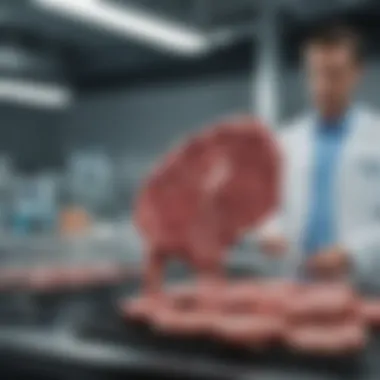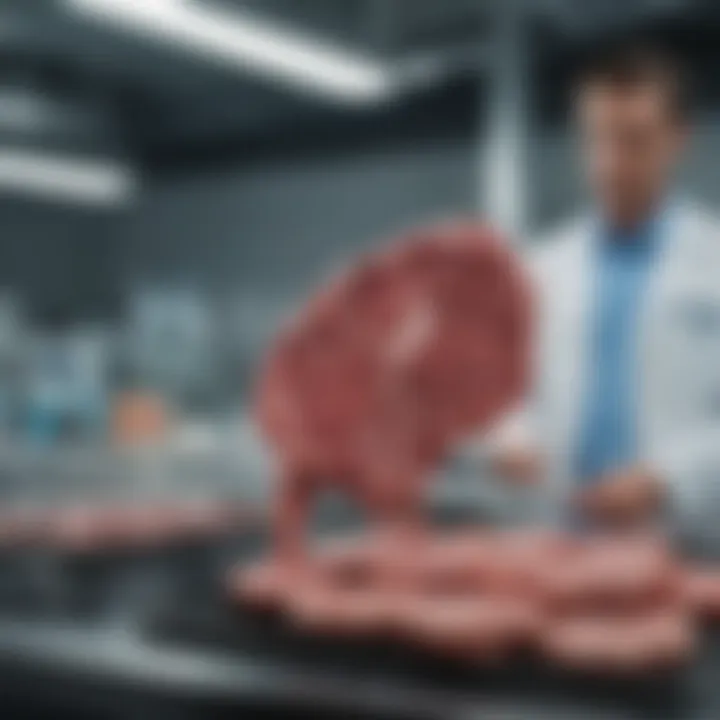Examining the Future of Artificial Meat Production


Intro
The world of food production is shifting rapidly, with the emergence of artificial meat changing the landscape of how we think about sustenance. No longer just a futuristic dream, artificial meat is becoming a real alternative to traditional livestock farming. This transformation carries far-reaching implications, from environmental sustainability to ethical considerations about animal welfare and resource allocation. Here is where we find ourselves at a crossroads – where science meets societal needs, a realm that demands careful exploration and understanding.
Just a few years ago, the concept of lab-grown meat seemed to dwell in the realm of science fiction. Now, it’s a reality backed by advancing technology and an increasing awareness of sustainability issues. This article seeks to illuminate the current state of artificial meat production by providing an in-depth analysis of its evolution, the technological advancements that have fueled its growth, and the socio-economic factors that accompany its rise to popularity.
As we journey through this topic, we will address essential questions surrounding artificial meat: What does it mean for our environment? How ethical is its production? And what are the future prospects as this field expands? These inquiries will serve as a foundation for understanding the complex dynamics at play in the production of artificial meat.
By dissecting these facets, we aim to present a well-rounded perspective that appeals to researchers, students, educators, and professionals alike who are curious about sustainable food systems and the broader implications of shifting away from conventional meat sources.
Preface to Artificial Meat
The concept of artificial meat isn't just another scientific fancy; it's an adventure into a new paradigm of food production that could reshape our daily lives. As the world grapples with environmental challenges like climate change and resource scarcity, the shift towards artificial meat emerges as a noticeable response. This article invites you to delve into the complex yet fascinating landscape of artificial meat production.
Understanding artificial meat's role goes beyond simply defining it; it touches on ecology, technology, and ethics. The importance of this topic resonates throughout various sectors, from agriculture to consumer behavior. It is not merely about producing meat without animals, but also about lessening the ecological footprint of our food systems, addressing food security, and advancing animal welfare. Here, we consider key elements like the various forms of artificial meat, innovations in production methods, and the societal implications that come along with its adoption.
In the following sections, we will explore specific benefits: how this industry promises sustainability through alternative protein sources, and the challenges that lie ahead in acceptance, regulation, and market penetration. The understanding we build here will empower readers to critically assess how artificial meat could alter our culinary landscapes and what this means on a global scale.
Definition and Types
Artificial meat, frequently referred to as cultured or lab-grown meat, is created using cellular agriculture technology. It is designed to mimic traditional meat while offering numerous advantages.
- Cell-Based Meat: Cultivated from animal cells, this type aims to replicate the muscle structure and taste of conventional meat.
- Plant-Based Meat: Made primarily from plants, this alternative focuses on providing similar textures and flavors as meat while being entirely vegan. Ingredients can include pea protein, lentils, and even fungi.
- Fermented Meat Products: This type uses microbial fermentation to create protein-rich foods. Examples include products developed by companies like Quorn.
The evolution of these types is significant, each presenting unique approaches to meet rising protein demands.
Historical Context
Artificial meat is the child of various innovations, but its roots stretch back to major advancements in biotechnology and food science. The first instances of cellular agriculture can be traced to the mid-20th century, when scientists began experimenting with tissue culture. However, it wasn’t until the early 2000s that serious research and development took place, led by innovators eager to challenge the traditional concepts surrounding meat production.
In 2013, the world watched as the first hamburger made from lab-grown beef was cooked and tasted in London, heralding a new era of meat production. This event not only sparked media curiosity but also raised essential questions surrounding ethical farming, environmental impacts, and resource management. Its success stirred conversations about food security, especially concerning a growing global population that demands sustainable methods to satiate hunger. As we move forward, understanding this history keeps us grounded in the bigger picture of where artificial meat stands in our modern culinary landscape.
Technological Innovations in Production
Technological advancements in artificial meat production play a crucial role in shaping the future of food sustainability. These innovations are not just pivotal for enhancing the efficiency and feasibility of production systems; they also have the potential to address pressing environmental concerns, ethical debates, and nutritional needs. The development of new technologies can lead to higher quality products, reduced environmental impact, and the ability to catering to diverse dietary preferences. As we dive deeper, it becomes evident why each method of production has its own importance amidst the growing demand for sustainable food sources.
Cell-Based Cultivation
Cell-based cultivation, often known as cultured meat or lab-grown meat, has taken the world by storm. The process involves multiplying animal cells in a controlled environment, eliminating the need for traditional animal farming. This technique not only has the potential to drastically reduce land use and greenhouse gas emissions, but it also offers a more ethical approach to meat production. With advancements in bioreactors and tissue engineering, scientists are perfecting the method to create texture and flavor that closely resembles conventional meat.
The benefits of cell-based meat are significant. For instance, it requires considerably less water compared to traditional livestock farming. According to recent studies, producing cultured meat could use up to 90% less water. Furthermore, it diminishes the risks associated with meat-borne diseases and antibiotic usage prevalent in conventional meat production. However, the challenges are equally notable. High production costs and public perception remain hurdles that must be addressed to make cell-based cultivation a mainstream choice.
Plant-Based Alternatives
Plant-based alternatives have carved a niche in the food landscape. They offer a variety of options for those who lean toward vegetarianism or want to cut down on meat consumption without sacrificing taste or texture. Utilizing ingredients like peas, soy, and quinoa, these products are designed to mimic meat while providing complementary nutrients to the diet.
Ingredient Sources
The ingredient sources for plant-based meat play a role in ensuring nutritional adequacy while offering an appealing taste. Leguminous plants, including lentils and chickpeas, are commonly favored for their protein content and fiber. These sources not only provide essential amino acids but also optimize the environmental footprint by requiring significantly less water and land compared to animal proteins.
Unique feature: The ability to incorporate a wide range of plant-based ingredients allows for greater dietary inclusivity. For instance, ingredients can be tailored to cater to vegans and those with allergies. While they are generally perceived as a beneficial choice, the reliance on processing can sometimes alter their health benefits, creating the necessity for careful labeling and transparency.
Processing Techniques
Processing techniques are at the heart of how plant-based alternatives are shaped and seasoned to meet consumer expectations. Extrusion cooking, for example, is pivotal in achieving the right texture and mouthfeel. Through this method, raw materials are forced through a machine under high temperatures and pressures to create strands resembling ground meat.
The main advantage of advanced processing is its efficiency. Yet, there's a trade-off in terms of nutritional value—excessive processing can strip away beneficial nutrients. Additionally, some techniques may incorporate additives that could deter health-conscious consumers, making the sourcing of ingredients critical to the credibility of plant-based meat.
Fermentation Technologies


Fermentation technologies are gaining traction as another exciting avenue in artificial meat production. Through microbial fermentation, proteins can be produced that mimic the taste and texture of meat. This process offers an eco-friendly alternative by using renewable resources and lower energy inputs. Fermentation not only enhances flavor profiles but also promotes gut health through probiotic properties, positioning these products as nutritionally advantageous.
Fermentation can also contribute to the longevity of products, extending shelf life without the need for preservatives. The unique characteristic of using microorganisms to transform ingredients into something remarkably similar to meat opens new doors in culinary applications. However, challenges regarding scalability and consumer education remain instrumental for mainstream acceptance.
Environmental Impacts
The growing awareness around environmental sustainability plays an essential role in the discussion surrounding artificial meat. This section seeks to unpack the ecological ramifications of artificial meat production, examining how it stands against conventional meat production in critical areas like land use, water consumption, and carbon emissions. As more individuals and societies prioritize eco-friendliness, understanding the environmental impacts of artificial meat becomes crucial. It not only frames a narrative against established food systems but also provides insights into a potential shift towards sustainable practices in agriculture.
Land Use and Biodiversity
Artificial meat production promises substantial reductions in land use compared to traditional livestock farming. Raising cattle or poultry requires vast swathes of land, primarily for grazing and feed production. In contrast, cell-based meat technologies aim to create meat directly from animal cells, substantially cutting down on the space needed.
This shift can preserve natural habitats and protect biodiversity. For instance, regions that are typically cleared for grazing or growing feed crops could be restored to their natural states, fostering diverse ecosystems.
- Benefits include:
- Minimized habitat destruction: Less land is needed for meat production, allowing ecosystems to thrive.
- Preservation of endangered species: With enhanced land conservation efforts, the overall biodiversity may see a positive impact.
- Agroecological balance: There is a potential to create environments where farming coexists with natural habitats efficiently.
Nevertheless, it is vital to consider that not all artificial meat technologies may yield equal benefits. Different production methods could have varying impacts on land use. Continued research is needed to identify practices that support biodiversity effectively.
Water Consumption
Water scarcity is a pressing global issue. Traditional meat production consumes an alarming amount of water—estimates suggest it takes around 1,800 gallons of water to produce just a single pound of beef. In comparison, artificial meat production techniques tend to use considerably less water.
- Here are some key points:
- Less water-intensive: Cell-based production significantly reduces the need for water as it bypasses many stages in the meat production cycle.
- Efficient water use: Plant-based meats generally require even less water, as they are derived from crops that do not necessitate animal husbandry.
- Highlighting the importance of sustainable practices: Effective water management can drastically lower environmental footprints and prevent future crises.
Yet there’s a catch: sourcing raw materials for plant-based options also carries its own water footprint. So, tackling water use in artificial meat production isn't merely about reducing consumption; it requires a holistic view of all factors at play.
Carbon Footprint Comparisons
The issue of greenhouse gas emissions is central to environmental discussions surrounding food production. Traditional meat farming generates a hefty amount of carbon dioxide and methane, both crucial contributors to climate change. In contrast, artificial meat production typically boasts a much lower carbon footprint.
- Factors to consider include:
- Reduction of methane emissions: Livestock farming contributes significantly to methane release. By moving towards artificial production, we substantially cut down on these emissions.
- Energy-efficient production processes: Many artificial meat technologies offer optimized production processes, which may yield less energy consumption compared to conventional farming.
- Lifecycle assessment: A thorough analysis weighs the entire lifecycle of meat production from sourcing to display, emphasizing where reductions in carbon emissions can be realized.
Ultimately, the promise of artificial meat in reducing carbon emissions is significant, but it calls for detailed evaluations to assess the real-world benefits. Stakeholders must encourage technologies that prioritize a greener approach overall.
"The transition toward artificial meat has the potential not only to reshape diets but also to protect our planet's future.”
As artificial meat production continues to evolve, its environmental impacts remain a pivotal focus for researchers, businesses, and policy-makers alike.
Health Perspectives
Understanding the health perspectives surrounding artificial meat is crucial for evaluating its place in modern diets and its potential to contribute to public health. As the world leans into alternatives to traditional meat sources, factors like nutritional benefits, safety concerns, and overall health impacts weigh heavily on consumer acceptance and regulatory frameworks. The conversation about health extends beyond mere nutrition; it interlaces with ethics, environmental issues, and societal norms, thereby carving out a multifaceted viewpoint on artificial meat.
Nutritional Aspects of Artificial Meat
Artificial meat has garnered attention not only for its environmental implications but also for its perceived nutritional benefits. Many artificial meat products are designed to mimic the taste and texture of traditional meat while offering an improved nutrient profile. For example, brands such as Beyond Meat and Impossible Foods often include additional vitamins and minerals, such as B12 and iron, which are vital in meat consumption but sometimes lacking in vegan diets.
Moreover, some products lower the saturated fat content typical in beef or pork, making them heart-healthier options. However, one must scrutinize the ingredient lists closely, as some artificial meats can be high in sodium or contain digestive additives to enhance texture and flavor. Utilizing whole food ingredients can mask certain health drawbacks that processed versions might have.
"Like a wolf in sheep's clothing, some artificial meat may seem healthy but can harbor questionable ingredients!"
Food Safety Considerations
Food safety in the realm of artificial meat production must not be overlooked. With many processes still in development or gaining traction, ensuring that these products meet safety standards is paramount. Unlike traditional meat, which has well-established pathways for safety inspections, lab-grown or plant-based alternatives require new regulatory scrutiny.


For instance, cell-cultured meat could carry growth factors or hormones introduced during its growth. Likewise, plant-based substitutes might be prone to cross-contamination with allergens if not handled properly during production. This risk leads consumers to question if these alternatives are genuinely safe or just a novel risk to public health.
Thus, institutions like the U.S. Food and Drug Administration are tackling guidelines to ensure safety standards keep pace with innovation. It's essential for both manufacturers and consumers to stay informed about recalls, new findings, or updates in safety regulations.
End
The health perspectives surrounding artificial meat demand a careful and well-rounded exploration. As science continues to evolve, understanding how artificial meat affects dietary habits, nutritional intake, and overall health will determine its acceptance and implementation in food systems around the world. Keeping an eye on nutritional values, being mindful of food safety standards, and actively participating in discussions surrounding artificial meat will pave the way for healthier eating choices in the future.
Ethical and Societal Considerations
The discussion surrounding artificial meat production does not solely revolve around technological advancements or environmental benefits. One of the most compelling dimensions is the ethical and societal considerations that underpin this burgeoning industry. It digs deep into how artificial meat intersects with our values, traditions, and attitudes toward food, urging us to reassess long-held beliefs about animal farming and food consumption.
At the crux of these ethical considerations lies the welfare of animals. Traditional meat production has long been criticized for its treatment of livestock, often seen as part of the problem by animal rights advocates. With artificial meat, there's a compelling narrative that it could potentially alleviate suffering. By shifting towards lab-grown or plant-based alternatives, we might reduce the slaughter of animals and lessen the stress associated with factory farming. This perspective demands a thoughtful evaluation of whether our appetite for meat is worth the moral cost it incurs.
Animal Welfare Perspectives
The issue of animal welfare is paramount in the conversation about artificial meat. The underlying idea suggests that as technology progresses, we may approach a future wherein the reliance on animal farming diminishes significantly. For many, this is not just a minor shift but a profound re-imagining of our relationship with animals. Research has shown that consumers express desire for cruelty-free food options. In addressing these concerns, companies developing artificial meat products sometimes highlight their commitment to ethical sourcing, even when the source is non-animal. This aspect serves a dual purpose: appealing to consumers who prioritize humane treatment and positioning their products as solutions to a problem that many wish to rectify.
However, it’s important to recognize that how society presently views artificial meat varies significantly across cultures. Some regions embrace these innovations as a sign of progress, while others regard them as a deviation from well-rooted culinary practices.
"Shifting the production of meat from livestock to labs may challenge our physical and psychological dietary habits, requiring a reevaluation of cultural norms attached to food."
Cultural Acceptance and Resistance
When it comes to cultural acceptance, artificial meat stirs a tempest of opinions. Some cultures celebrate innovation and view artificial meat as a fascinating venture into the future of cuisine. They see it as a means to create a sustainable food supply that aligns with modern sensibilities. Conversely, there are groups firmly rooted in tradition, who may resist artificial solutions like lab-grown meat due to a belief that food should be sourced in a natural way.
Factors influencing acceptance often include demographics and education levels. Young urban populations may exhibit more openness, whereas older, rural communities often cling tightly to traditional food practices. Cultural narratives shape our eating habits, and artificial meat’s integration into daily life requires a delicate balance that respects these narratives.
To bridge the divide between proponents and skeptics, education plays a crucial role. Clear and transparent communication about the benefits of artificial meat, grounded in scientific research and ethical considerations, can help alleviate fears and misconceptions. It's about fostering dialogue and broadening perspectives on how we connect with our food system.
Economic Factors and Market Trends
Understanding the economic landscape surrounding artificial meat production is essential to grasp its future implications. The interplay between investment, consumer demand, and market dynamics shapes not just the current reality but also the potential growth trajectories of this sector. As the world grapples with increasing food security concerns and environmental pressures, artificial meat emerges as a viable alternative, signaling shifts in both production methodologies and consumption patterns. Recognizing the nuances in these trends offers insights into how society might embrace or resist this innovation.
Investment Landscape
Investments in artificial meat production have grown exponentially, reflecting a burgeoning interest from venture capitalists, corporations, and even government entities. The market has seen significant financial backing for startups engaged in innovative biotechnological advancements. For instance, companies like Memphis Meats and Mosa Meat have attracted millions in funding, underscoring the belief that artificial meat can disrupt traditional agricultural practices.
- Types of Investments:
Investments range from early-stage venture capital that fuels research and development, to large multinational corporations acquiring stakes in emerging firms, to grants from government programs aimed at supporting sustainable food initiatives. - Market Valuation Trends:
According to industry reports, the global market for cultivated meat is predicted to reach a valuation of billions in the upcoming years. This growth reflects not only consumer interest but also the pressure on food systems to adapt to changing environmental and health needs. - Challenges in Investment:
Despite the optimistic outlook, investors face hurdles such as regulatory uncertainties and the long road to commercialization, which can create hesitation in funding. The unpredictability of returning investment compels stakeholders to navigate carefully.
Consumer Demand and Preferences
Consumer preferences significantly shape the artificial meat landscape. The rising consciousness around sustainability, health, and ethical considerations is driving more consumers to consider alternatives to conventional meat. Within this context, several factors are influencing consumer behavior:
- Health Consciousness: Consumers are becoming increasingly health-aware, looking for options that offer better nutrition without the downsides commonly associated with traditional meat, such as high saturated fat and antibiotic use.
- Sustainability Concerns: Many individuals are gravitating towards products that promise a lower carbon footprint and minimal land use. The preference for eco-friendly options often translates into a willingness to pay a premium for artificial meat products, which position themselves as sustainable alternatives.
- Cultural Influences: Cultural acceptance varies, influencing consumer adoption rates. In some cultures, there may be reluctance towards meat alternatives due to traditional culinary practices, while others embrace these innovations.
"Transforming dietary habits is a gradual process. The shift to artificial meat involves stripping away long-held perceptions of food production, which can be a tough nut to crack."
The future will likely see a confluence of these trends, where artificial meat may not just be an alternative but could become a staple for a growing segment of the population. As the technology matures and market dynamics evolve, understanding these economic factors will be crucial for anyone involved in the artificial meat production field.
Global Perspectives on Artificial Meat
As the world grapples with pressing food security and environmental challenges, the discussion around artificial meat extends beyond technological advancements to encompass global perspectives. Understanding how various nations approach artificial meat production is critical. It provides insight into regulatory scenarios, cultural nuances, and collaborative efforts that shape the future of this emerging industry.
From an economic standpoint, countries face a delicate balancing act between innovation and consumer acceptance. In places where traditional livestock farming is a cornerstone of the economy, the shift toward artificial alternatives may feel as if a rug is being pulled out from under their feet. Conversely, regions with a strong tech sector might embrace artificial meat as a game changer in both food supply and job creation.
Furthermore, environmental considerations weigh heavily on these discussions. Countries with ecological mandates are scrutinizing the sustainability of their food production systems. The role of artificial meat in potentially reducing land and water use presents a compelling argument for those nations. It invites governments to consider legislation that promotes sustainable practices while ensuring food security.
"The global food system is at a crossroads; our choices today will dictate the health of our planet tomorrow."


Lastly, cultural frameworks should not be overlooked. Acceptance of artificial meat varies greatly among populations. Cultural perceptions of food can dramatically influence regulatory approaches and market receptivity. Countries that prioritize ethical considerations may actively promote plant-based and cell-based protein as a way to reduce animal suffering and environmental degradation.
Regulatory Frameworks Across Nations
Examining regulatory frameworks reveals a patchwork of policies and guidelines, reflecting local economies, cultural values, and political agendas.
- United States: The regulatory landscape is dominated by the FDA and USDA. Both agencies play roles in the approval process for lab-grown meat, though specifics often remain in flux as guidelines evolve. They focus on safety, labeling, and dietary impact.
- European Union: EU member states have implemented stricter regulations due to heightened public scrutiny. Safety assessments and consumer transparency are prioritized, and there is ongoing debate about how to classify and label these products.
- Asia: Countries like Singapore have adapted quickly to innovations in food technology, issuing the world’s first regulatory approval for lab-grown meat. This willingness to innovate stands in contrast to traditional practices, fostering a unique local market dynamic.
In each case, the extent of public engagement and scientific discourse plays a significant role in shaping these regulations. Nations with higher public engagement often see more comprehensive frameworks and quicker adaptations to new technologies, showcasing the intricate dance between governance and grassroots acceptance.
International Collaborations and Research
Internationally, the landscape of artificial meat is being molded by collaborative efforts across borders. Various research institutions, startups, and established companies are pooling their resources and knowledge to tackle the complex challenges posed by artificial meat production.
Key Areas of Collaboration:
- Research Initiatives: Joint research projects aiming to refine production techniques are emerging. For instance, scientists in the Netherlands and Israel are partnering to enhance cell culture methods, driving efficiencies and lowering costs.
- Policy Development: Organizations such as the FAO and WHO are collaborating with countries to establish guidelines for sustainable artificial meat production, acting as a bridge between innovation and public health.
- Funding and Investment: Many international venture capital firms are backing startups in various regions, creating a comprehensive funding network that supports research and production facilities worldwide. This global funding landscape enables faster R&D cycles.
Given this interconnectedness, the future of artificial meat is not just in the hands of individual nations but is being crafted by collective actions. Nations and companies are reminded that collaboration is not merely an option but a necessity in navigating the multifaceted challenges of food production in a changing world.
Future Prospects and Challenges
The journey of artificial meat production is still very much in its infancy, yet it holds the potential to revolutionize the food industry. With the global demand for meat expected to soar in the coming years, addressing the sustainability and ethical dilemmas associated with traditional meat production is paramount. The future of artificial meat is likely to intertwine technological prowess with ethical considerations, reshaping not only our diets but also the agricultural landscape. This section delves into the two critical facets of future prospects and challenges that artificial meat production faces, examining how advancements in technology could be a game-changer and the skepticism that still looms over consumers.
Technological Advancements on the Horizon
As the old saying goes, necessity is the mother of invention. With global meat consumption projected to rise, there's significant impetus behind developing artificial meat technologies. Innovations such as precision fermentation, 3D printing of meat products, and enhanced cell-based techniques are emerging. By harnessing these advanced methodologies, there’s the potential to create textures and flavors that closely resemble traditional meat, thus making the transition more appealing to consumers.
- Precision Fermentation: This technology involves programming microorganisms to produce proteins and fats that mimic those found in meat. Companies like Perfect Day are already utilizing this technique to create dairy proteins without involving cows.
- 3D Printing: Some startups are pushing boundaries by using 3D printing to create customized meat products, tailoring taste and nutritional profiles for specific consumer demands.
- Enhanced Cell-Based Techniques: Recent breakthroughs have improved the efficiency of cell culture processes, reducing costs and time required for production, making it more accessible for commercialization.
However, keeping pace with advancements is not merely about innovation; it's also about adaptation. The industry needs to focus on scaling up production methods while ensuring that the quality remains exemplary. The challenge lies in making these technologies affordable and widely available, thus fostering broader acceptance among consumers who still have reservations about the integrity of these products.
Addressing Public Skepticism
Skepticism surrounding artificial meat products is as much a hurdle as consumer acceptance is a goal. The apprehensions primarily stem from concerns about safety, health implications, and the perceived unnaturalness of these alternatives. For many, the idea of 'meat' derived in a laboratory setting does not sit well.
The industry must tackle these hurdles head-on, and transparency is key. Here’s how:
- Clear Information Sharing: Educating the public about the production processes, along with the rigorous testing and safety standards that meet or exceed those in conventional meat production, is vital.
- Engaging with Critics: Constructive dialogues with critics can help demystify artificial meat. Engaging scientists, nutritionists, and chefs in discussions can provide credible endorsements that reassure consumers.
- Public Sampling Initiatives: Tasting events where consumers can try artificial meat products without any pressure could replace skepticism with curiosity. This could help diminish the divide between perception and reality.
Moreover, aligning the benefits of artificial meat—such as lower environmental impact and ethical meat production—with consumer values can be a powerful step.
"Innovation in artificial meat production is about more than just creating alternatives; it's about enhancing public trust and redefining what we put on our plates."
As we navigate the complexities of future prospects and challenges, it's clear that overcoming public skepticism while surging forward with technological advancements will be instrumental in determining the role of artificial meat in the food system.
Closure: The Path Forward
As this article wraps up, it shines a light on the vital importance of understanding artificial meat production. This field is something more than just an alternative to traditional meat; it represents a potential shift in how we consider food systems, sustainability, and ethical consumption. In piecing together the various facets of artificial meat—from technological advancements to its environmental impacts—we gather insights that are not merely academic, but are pivotal for shaping policies and practices in the near future.
Synthesis of Insights
In reflecting on the contents discussed, it becomes clear that artificial meat embodies a convergence of technological innovation and ethical imperative. Throughout this article, key points highlight that:
- Technological Innovations: Cell-based cultivation and plant-based options play central roles in developing sustainable food sources.
- Environmental Benefits: The potential for reduced land use, lower water consumption, and diminished carbon footprints make artificial meat a compelling solution to some of the planet's pressing existential problems.
- Health and Safety Concerns: Addressing these head-on will be crucial to establishing public trust and ensuring that artificial meat can be seamlessly integrated into diets around the world.
- Ethical Implications: The conversation around animal welfare, although multifaceted and often contentious, can lead to societal shifts that add positive dimensions to the benefits of artificial meat.
These elements come together to paint a comprehensive picture of why exploring artificial meat production isn’t just a trend but a necessary step toward securing a future that is not just sustainable but also equitable.
"Increasing awareness and understanding of artificial meat production can foster acceptance and encourage consumers to make informed choices about their diets and the future of food."
Call for Interdisciplinary Research
The path forward must prioritize interdisciplinary research. Comprehending the full impact of artificial meat extends beyond the fields of food science, engineering, and environmental studies. Researchers from economics, sociology, psychology, and health sciences should collaborate to create an integrated approach to understanding artificial meat's implications.
Such collaborative studies can yield valuable insights into:
- Consumer Behavior: Understanding what drives public acceptance or rejection of artificial meat.
- Regulatory Implications: Assessing how different regulatory environments influence production and market dynamics.
- Cultural Contexts: Examining how various cultures perceive artificial meat and its acceptance within diverse dietary practices.
- Economic Viability: Modeling scenarios to explore the financial implications of large-scale production versus traditional meat farming.
By merging these disciplines, the research can create a more nuanced understanding of artificial meat's role in fostering sustainable food systems. This holistic perspective is vital not only for guiding policy decisions but also for nurturing a well-informed public discourse that champions both innovation and ethical standards.
To sum it all up, the road ahead involves careful consideration, innovative thinking, and cooperative efforts across various domains of study. With keen focus and collaborative spirit, artificial meat production can very well be one of the cornerstone technologies that help navigate the challenges facing the global food supply.



